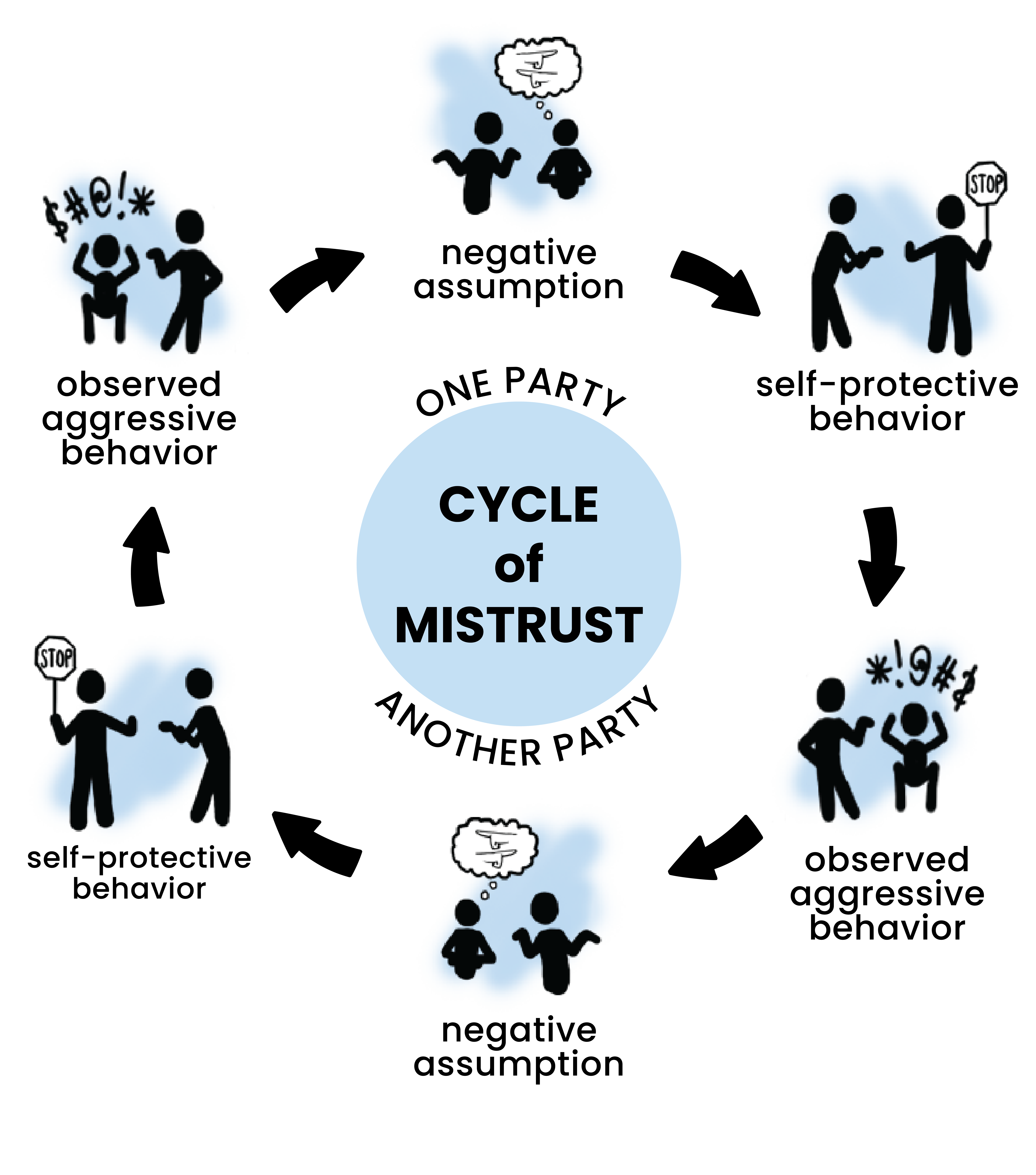Have you ever felt that someone’s behavior was hostile or aggressive towards you, formed a negative opinion about them and then taken protective action(s) against them?
If so, you’ve likely participated in a Cycle of Mistrust.
In their must-read book, Driving Fear Out of the Workplace: Creating the High-Trust, High-Performance Organization, Kathleen Ryan and Daniel Oestreich described Cycles of Mistrust as a kind of organizational flu.
The cycle looks like this:

The cycle may begin at any one of the six starting points above.
The authors describe each step as follows:
-
Negative assumptions: A manager adopts negative beliefs about an employee’s intentions, style, or behavior.
-
Self-protective behavior: The manager behaves in ways that are self-protective, acting to defend against the employee’s potential to harm or hinder the manager.
-
Observed aggressive, confusing, frustrating, or irritating behavior: The employee sees the manager’s self-protective behavior and interprets it as intended to harm or block the employee in some way.
-
Negative assumptions: Based on this interpretation, the employee adopts negative beliefs about the manager’s intentions, style, or behavior.
-
Self-protective behavior: The employee acts in self-protective ways in order to defend against the manager’s potential to harm or block the employee.
-
Negative assumptions: A manager adopts negative beliefs about an employee’s intentions, style, or behavior.
A Real Example
Let’s look at a real-world example, beginning with a supervisor forming a “Negative Assumption” and continuing clockwise around the Cycle of Mistrust:
Cycle One:
-
Negative assumption: Supervisor thinks that an employee is lazy and unconcerned with company finances because he doesn’t fill out his timesheet.
-
Self-protective behavior: Supervisor sends a note to the employee’s manager.
-
Observed aggressive behavior: Employee is confronted by their manager.
-
Negative assumption: Employee doesn’t like “getting in trouble” for useless administrivia when he is working so hard for the company.
-
Self-protective behavior: Employee fills out timesheet using a quick & dirty approach, making sure to document all of the hours he worked, which is often beyond 40 hours per week.
-
Observed aggressive behavior: Supervisor observes that timesheet categories aren’t used correctly and more than 40 hours are submitted, which causes problems for accounting and forces her to make time-consuming adjustments.
We’ve only made one trip around the cycle of mistrust. Unfortunately, the cycle tends to continue, getting worse with each rotation…
Cycle Two:
-
Negative assumption: Supervisor thinks the employee is a slacker who doesn’t care about all the work he is making for her.
-
Self-protective behavior: Supervisor calls employee’s manager again to discuss the problem.
-
Observed aggressive behavior: Employee’s manager has another discussion with them about the supervisor’s problem with time sheets.
-
Negative assumption: Employee feels as though they are being micromanaged because they are not trusted.
-
Self-protective behavior: Employee fills out timesheet using correct categories but still includes hours over 40 to document all of the time spent on work.
-
Observed aggressive behavior: Supervisor assumes that the employee just doesn’t care about all of the re-work they are creating.
And so on…
So what is happening in these cycles of mistrust?
Not a whole lot of real communication or understanding!
In this particular example, the employee doesn’t understand what the supervisor does with the time sheet data or the fact that late or inaccurate time sheets lead to late invoices, which lead to late payments by clients, which lead to late payments to staff, which lead to stress and unhappy staff who may consider getting jobs with different employers. Similarly, the supervisor doesn’t understand how little the employee knows about the purpose of time sheets, the significance of the work categories used in time sheets, the irrelevance of any hours documented over 40, etc.
What we have here is a failure to communicate. And when that occurs, cycles of mistrust grow like weeds.
Clearly what is needed here is not more aggressive behavior but a company-wide dialogue about time sheets that highlights what they are for, why they are used, how they are meant to be used, etc. Such a dialogue could in fact lead to productive changes to the process, making everyone happier.
In fact, the above example resembles an issue within Industrial Logic. New employees had been inheriting a time tracking system without an explanation for why it existed or what is what truly meant to achieve. A cycle of mistrust developed because communication and trust were sorely lacking.
We broke that cycle of mistrust by having a company-wide discussion about time sheets, openly discussing issues with time sheets and modifying the process to be far simpler.
Breaking Cycles of Mistrust
The first step in breaking cycles of mistrust is to become aware of them. There are many ways to approach that. One way is for employees and supervisors to privately fill out what they believe is happening during the six steps of the model. Then, if it feels safe, they can discuss their perspectives, perhaps with a trust facilitator.
In my experience, many cycles of mistrust are born out of poor communications, assumptions and an environment that is lacking in collaboration and shared understanding.
I will conclude this post with some wise words from the authors of Driving Fear out of the Workplace:
“We have found that when people understand the dynamics of the cycle and how it can influence behavior, they become both better able to let go of mistrust and more tolerant of feedback from others. It is very easy for anyone getting feedback in an environment of mistrust to take things personally and be offended by other people, alleging that they have some type of negative motive. But with a thorough understanding of the cycle, these tense situations can be viewed more objectively, and some of what might have gotten under someone’s skin can be seen for what it is: a pattern of negative assumptions to be dealt with constructively. The trap can be avoided by seeing dynamics of the cycle work. When this understanding is coupled with an explicit vision of trust, a leader is in a strong place to begin turning around relationships that have become undermined by fear.”




